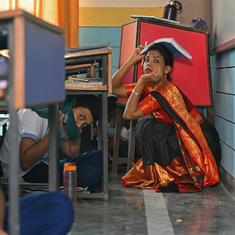Trilogy veteran Peter Jackson rolls out the concluding chapter of his adaptation of JRR Tolkien’s The Hobbit, which predates the events in The Lord of the Rings set of stories. The third part follows from An Unexpected Journey and The Desolation of Smaug. Various squabbling factions lock swords and grimaces for one last face-off in The Battle of the Five Armies. It’s yet another beards-and-brawn saga, with the usual themes of friendship, trust, loyalty, bravery, betrayal, cowardice, love and loss explored through impressively staged scenes that are also available for 3D for enhanced effect.
The movie wastes little time to get going, opening with a spectacular sacking of Lake Town by the dragon Smaug (voiced by Benedict Cumberbatch), who has been awakened from his slumber by the hobbit Bilbo Baggins (Martin Freeman) and forced to leave the gold-laden Lonely Mountain castle that used to be a seat of power for the dwarves. Once Smaug is taken care of, the dwarves, led by the increasingly power-hungry Thorin (Richard Armitage) lay claim on the gold, as do the Elves led by Thranduil (Lee Pace), the orcs and Lake Town’s remnants who rally around Bard the Bowman (Luke Evans). Gandalf the Grey, the senior citizen-friendly wizard who also appeared in the first trilogy, and was imprisoned by the evil Sauron in The Desolation of Smaug, breaks free to bring up the fifth army and provide the link between this trilogy and the happenings of LOTR.
Jackson’s skill in carving a straight line through the cross-crossing subplots of Tolkien’s dense, proto-hyperlinked text is one of the most remarkable aspects of both trilogies. So is his ability to visualise Tolkien’s world and bring to life the writer’s bewildering arrays of characters and their tribal passions. Jackson can also handle movement in general and action sequences in particular with enough dexterity to make it look very easy.
Uneasy pace
He starts The Battle of the Five Armies with momentum but often slows down the movie, unconvinced of its identity as a third act that needs to wrap quickly, and unwilling to close the portal into the wonders of Tolkien that he opened with The Fellowship of the Ring in 2001. The characters in this trilogy are not as compelling as the previous one, even though some of them are repeats (Gandalf, Cate Blanchett’s Galadriel, Christopher Lee’s Saruman). Freeman’s Bilbo Baggins was a fit right from the start, and as is the case with the other films, peripheral characters get their YouTube-worthy moments. But Armitage’s Thorin is no match to Viggo Mortensen’s Aragorn despite the similarity in appearance. His conflict between his lust for the heaps of gold at the Lonely Mountain and his duty towards the dwarves isn’t interesting enough to merit the attention it gets..
Jackson’s tendency to have at least three endings, most yawn-inducingly evident in The Return of the King, persists in The Battle of the Five Armies. He had originally planned The Hobbit as a two-part film, and it might have been better that way. The parallel universe of men, half-men, dwarves, monsters, wizards, evil spirits, and benign forces has been deeply satisfying, but it needn't consume a lifetime.
We welcome your comments at
letters@scroll.in.
The movie wastes little time to get going, opening with a spectacular sacking of Lake Town by the dragon Smaug (voiced by Benedict Cumberbatch), who has been awakened from his slumber by the hobbit Bilbo Baggins (Martin Freeman) and forced to leave the gold-laden Lonely Mountain castle that used to be a seat of power for the dwarves. Once Smaug is taken care of, the dwarves, led by the increasingly power-hungry Thorin (Richard Armitage) lay claim on the gold, as do the Elves led by Thranduil (Lee Pace), the orcs and Lake Town’s remnants who rally around Bard the Bowman (Luke Evans). Gandalf the Grey, the senior citizen-friendly wizard who also appeared in the first trilogy, and was imprisoned by the evil Sauron in The Desolation of Smaug, breaks free to bring up the fifth army and provide the link between this trilogy and the happenings of LOTR.
Jackson’s skill in carving a straight line through the cross-crossing subplots of Tolkien’s dense, proto-hyperlinked text is one of the most remarkable aspects of both trilogies. So is his ability to visualise Tolkien’s world and bring to life the writer’s bewildering arrays of characters and their tribal passions. Jackson can also handle movement in general and action sequences in particular with enough dexterity to make it look very easy.
Uneasy pace
He starts The Battle of the Five Armies with momentum but often slows down the movie, unconvinced of its identity as a third act that needs to wrap quickly, and unwilling to close the portal into the wonders of Tolkien that he opened with The Fellowship of the Ring in 2001. The characters in this trilogy are not as compelling as the previous one, even though some of them are repeats (Gandalf, Cate Blanchett’s Galadriel, Christopher Lee’s Saruman). Freeman’s Bilbo Baggins was a fit right from the start, and as is the case with the other films, peripheral characters get their YouTube-worthy moments. But Armitage’s Thorin is no match to Viggo Mortensen’s Aragorn despite the similarity in appearance. His conflict between his lust for the heaps of gold at the Lonely Mountain and his duty towards the dwarves isn’t interesting enough to merit the attention it gets..
Jackson’s tendency to have at least three endings, most yawn-inducingly evident in The Return of the King, persists in The Battle of the Five Armies. He had originally planned The Hobbit as a two-part film, and it might have been better that way. The parallel universe of men, half-men, dwarves, monsters, wizards, evil spirits, and benign forces has been deeply satisfying, but it needn't consume a lifetime.










